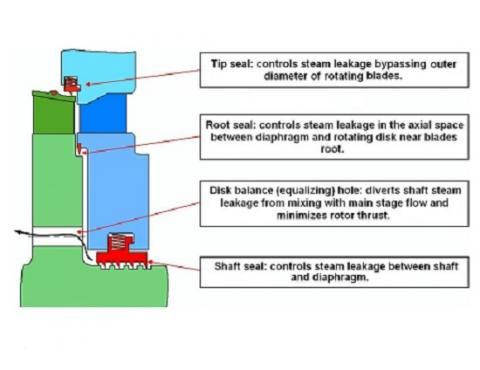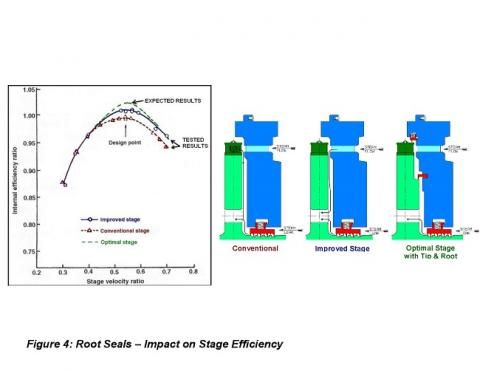Evolution in interstage seals

Long term operation and extensive R&D of steam turbines have shown that steam leakages from the main steam flow beyond the rotating blade shrouds and their roots as well as between the shaft and diaphragm ID is the main source (75-81%) of turbine performance deterioration due to:
- Missing energy of steam leaving or bypassing the main flow
- Disturbances in main flow (wakes, eddies, etc.) from collisions of leaked steam with the main flow
Therefore, in order to minimize and contain these leakages, the modern impulse turbine stage incorporates three types of seals: tip seals, root seals and shaft seals (Figure 1).
Tip Seals
Tip seals are used to prevent steam leakage into the space above the rotating blades. Among the stage seals, this leak is the largest source of efficiency loss due to the largest leak area and the highest reaction (i.e.pressure drop) in this location. All in all, any fully functional radial tip seal improves the stage efficiency by approximately 2.5% compared to the axial rigid seal. However, it is possible to achieve a much higher efficiency increase, especially in HP and LP steam path areas, by the combination of advanced tip seals and other design improvements (optimal tangential vane lean, profile end contour, moisture removal, etc.).
Root Seals
Root seals perform two functions. First, they prevent shaft leakage from entering into the main steam flow resulting in an increase of stage reliability and efficiency. Second, they prevent leakage from the main steam flow into the space between the diaphragm and disk faces and into the disk equalizing holes, maintaining high efficiency.

Figure 4 shows the test results of some root seals provided by MHI and Russian R&D. It is evident from these tests that a proper root seal design can result in a 1.5-2% efficiency increase per stage.
Shaft Seals
These seals prevent steam leakage between the shaft and diaphragm ID. The main engineering and R&D efforts were to create a labyrinth seal with minimal radial clearances between its fins and rotor. At the same time, this labyrinth seal must prevent rubbing and wear which mostly takes place during start-up and shut-down regimes when the rotor goes through the 1st critical speed. Retractable shaft seals improve stage efficiency by approximately 2-3% (together with a reliability increase) compared to the standard spring-back seals. Retractable brush seals result in further stage efficiency increase by approximately 1-2
Previous articles
Optimal edge-to-edge clearance in blades
Contoured end wall in HP nozzle rings and diaphragms
Optimal tangential lean of vanes